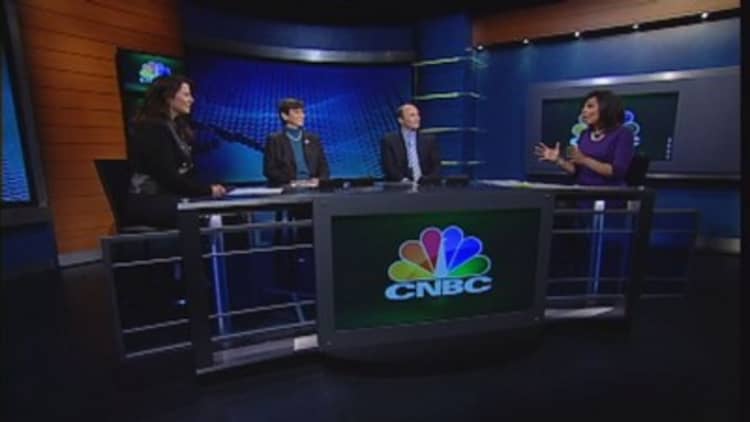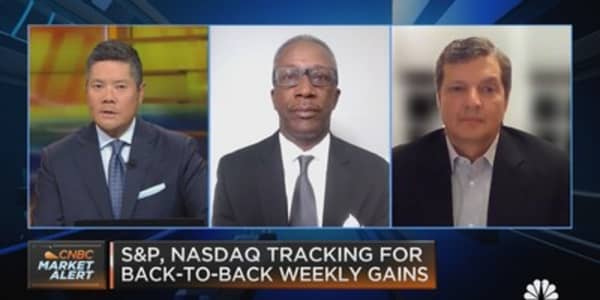
And you thought feathering your nest egg was tough. As you transition from collecting a paycheck to living off your savings, which for most occurs in their 60s and early 70s, all those years of retirement planning get put to the test.
You'll need to determine how much you can safely withdraw from your portfolio so you don't deplete your principal, convert your collection of taxable and tax-deferred accounts into a stable income stream and adjust your asset mix to minimize market shocks.
"The transition from accumulation to deaccumulation poses a psychological as well a financial challenge," said Bob Adams, a certified financial planner with Armstrong Retirement Planning. "It requires financial planning, as well as some key choices and trade-offs for the retirees around their own goals and objectives."
Longevity risk, or the chance you'll outlive your money, is by far the biggest threat to a secure retirement. The best defense on that front is a good offense, he explained.
Before you call it quits on your career, Adams advises crunching the numbers to ensure your savings are sufficient to maintain your standard of living.
(Read more: Growing nest eggs gets easier after 50)
Evaluate your assets and project your retirement income, including pensions and Social Security, along with your living expenses—for example, mortgage, car payments and travel—to determine whether you can comfortably cover your bills.
"Too many blindly and arbitrarily retire at a certain age without regard to the financial ramifications," Adams said. "Many retirees find that the costs of medical care and protecting against longevity are much higher than they may have expected."
Delaying retirement by even a year or two, he noted, can improve your future cash flow significantly.
Not only does extra time in the workforce allow you to continue contributing to your individual retirement account (IRA) or 401(k) plan, but it also gives your nest egg the chance to deliver compounded returns longer.
(Read more: 40-plus? It's not too late to save)
Added bonus: You may also be able to postpone Social Security by a few extra years, which can greatly increase the size of your benefit checks. This is one of the most effective strategies for boosting your retirement income if you've undersaved.
If your full retirement age is 65 years and six months, for example, you'll receive 100 percent of your benefit by retiring on time. If you hold off until age 67, however, you'll get 110.5 percent of the monthly benefit. And by waiting until age 70, you'll get 131.5 percent. (Benefits stop increasing at age 70.)
It's also good policy before you retire to give your income stream a test drive, said Elliot Herman, a certified financial planner and certified public accountant with PRW Wealth Management. Try living off your projected income for several months to see how it feels.
(Read more: Slow, steady best way to save in your 30s)
Remember, you may be spending less on lunches and commuting costs, but you may need more for travel and entertainment. You'll definitely need more for health-care costs, which increase considerably in the last decade of life.
"We advise clients to create a budget, prepare a cash flow and stress-test the cash flow under different assumptions," Herman said.
Watch your withdrawal rate
Regardless of how much you have set aside, the key factor that determines whether your savings will last as long as you do is how much you withdraw from your nest egg each year.
Gil Armour, a certified financial planner with SagePoint Financial, recommended that retirees use an initial withdraw rate of between 4 percent and 5 percent, adjusting that figure higher annually to account for inflation.
"Any higher and you risk irreversible damage to the balance if you encounter a nasty bear market early in your retirement and deplete too much of your nest egg," said Armour, noting those with considerable wealth or guaranteed income may be able to take more.
(Read more: Twenty-somethings should save for retirement)
Bear markets, indeed. Absent the flow of steady paychecks, Armour suggested retirees insulate themselves against market risk by maintaining an emergency fund in a liquid account that covers six months' worth of living expenses, ensuring they won't have to sell into a down market.
With interest rates on savings accounts near zero, however, locking up much more presents costs to the investor, who could be earning 7 percent or more in the stock market, he said.
It might intuitively feel right to keep the money 'safe' ... but the opposite is true because inflation, higher medical costs and longevity require solid growth to overcome.Bob Adamscertified financial planner, Armstrong Retirement Planning
During your golden years, your investment-strategy focus shifts from capital appreciation to wealth preservation.
As such, your asset allocation should now reflect a more balanced mix of stocks and bonds, Adams stressed.
More conservative investors should have roughly 60 percent of their portfolio in fixed-income securities—including bonds, tax-exempt bond funds, real-estate investment trusts and certificates of deposit—with the remaining 40 percent in equities, such as mutual funds and individual stocks, he noted.
The inverse allocation would be appropriate for an aggressive investor or one who needs to pursue growth.
Whatever your tolerance for risk, just be sure you're not too conservative with your portfolio, warned Adams, who noted new retirees may live 30 more years off their savings and need to achieve a reasonable rate of return.
(Read more: My, oh myRA, what a mess this will be)
"It might intuitively feel right to keep the money 'safe,' such as putting a lot in a money market fund for years at a time, but the opposite is true because inflation, higher medical costs and longevity require solid growth to overcome," he said.
As such, retirees should have only a small portion of their retirement-income stream tied to noninflation-adjusted fixed payments.
"Oftentimes, annuities and most nongovernment pensions are not inflation-adjusted," Adams said. "This means that in as little as 15 years, assuming 3 percent inflation, a $7,000 fixed-payment stream will have declined an amazing 37 percent to only provide the same purchasing power as $4,500 at the time of retirement."
Protect your assets
Given the rising cost of health care, SagePoint Financial's Armour recommended that middle-income retirees also consider long-term-care insurance, which covers in-home and facility-based assisted-living services.
(Those with little savings, he noted, typically use Medicaid as a backup option if all assets are depleted, while those who are wealthy can afford to effectively "self-insure," spending hundreds of thousands of dollars of their own assets without compromising their lifestyle.)
"For those in the middle ranges of net worth, obtaining a long-term-care insurance policy may be a prudent move to protect against the catastrophic costs of nursing home or in-home medical expenses," said Armour.
(Read more: Are you sick over future health-care costs?)
A 2013 survey by Genworth Financial found at least 70 percent of people over 65 will need long-term-care services and support at some point in their lifetime. The median annual rate for a private nursing-home room was $83,950 in 2013, up from $67,525 in 2008.
Creating income
One of the biggest financial challenges during retirement, by far, is converting your pots of gold into a stable source of income. Most retirees have a mixed bag of tax-deferred IRAs, tax-free Roths, taxable brokerage accounts and personal savings from which to draw.
You can maximize your income and growth potential, however, by putting a tax-savvy strategy into play, Adams explained.
As a general rule, retirees should tap their brokerage accounts first, since the capital-gains tax rate may be more favorable than the ordinary income-tax rate you'll pay when withdrawing from tax-favored accounts, such as a traditional IRA or 401(k). That strategy also enables your IRA and 401(k) to deliver tax-deferred growth longer.
Once your taxable accounts are drained, move to your tax-deferred accounts, including 401(k)s and traditional IRAs.
(Read more: Roth IRAs, state taxes don't mix)
The IRS requires taxpayers to begin taking required minimum distributions from their tax-deferred accounts at age 70½, regardless of whether they need the money.
Failure to take RMDs, or to withdraw the full amount of the RMD, results in a hefty 50 percent excise tax on the amount not distributed.
Leave your tax-free accounts, such as your Roth IRA, for last, Adams said.
Because these accounts are funded with after-tax dollars, the earnings grow tax-free.
There is no required minimum distribution for a Roth IRA, as there is for some annuities, traditional IRAs, 401(k)s and other retirement accounts, so it can continue delivering compounded returns. Any unused money left in the account when you die can be passed along to your heirs, whcan then withdraw the money tax-free.
(Read more: When was the last time you reviewed your 401(k)?)
Thus, Roth IRAs can be a valuable estate-planning tool as well.
Many retirees opt to liquidate a portion of their portfolio to purchase an annuity, such as a guaranteed lifetime income annuity, which provides guaranteed income for life, but such products can be costly and complex.
PRW's Herman noted that immediate fixed annuities with inflation rider protection are the better bet and may give retirees the confidence to pursue a more aggressive, growth-oriented investment strategy.
Still, SagePoint's Armour said, annuities should not constitute a majority of most retirees' portfolios, as they limit growth potential.
"Allocate only enough assets into an annuity to pay off or cover your fixed expenses, and leave the rest of your assets in the market to grow," he said.
Lastly, retirees who are house-rich but cash-poor may be able to convert a portion of their home equity into income without having to sell or surrender the title.
Borrowers who are 62 or older can receive a lump sum or monthly payment based on the equity in their home. The loan gets repaid with interest when they die, sell the home, or move away.
(Read more: How to get out of an annuity)
Because the balance of the loan continues to grow, however, it can reduce the size of the borrower's estate and thus the amount they leave to their heirs.
Retirement can be a fulfilling stage of life—if you plan ahead.
By budgeting smart and managing your withdrawal rate, you will not only ensure your savings will last but also enjoy the financial freedom to pursue new interests.
"When I work with clients, I create an inflation-adjusted retirement salary, the amount which I project they will have available to cover their expenses and taxes each year," Adams said. "This gives both a benchmark for spending and also a sense of comfort from having some structure."
—By Shelly K. Schwartz, Special to CNBC.com





